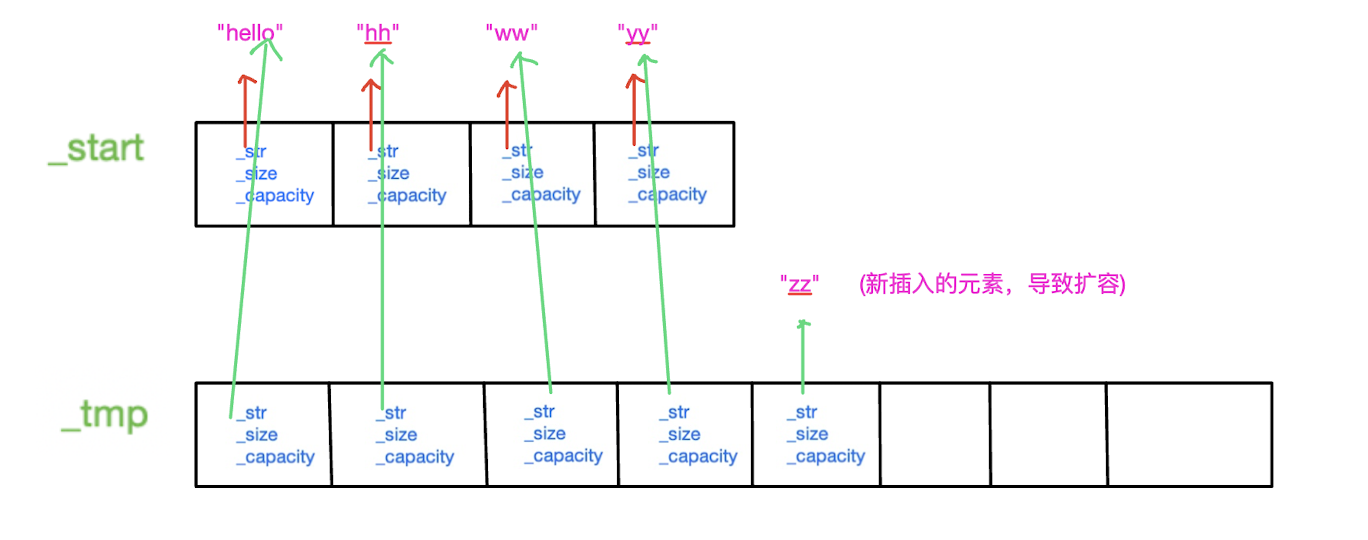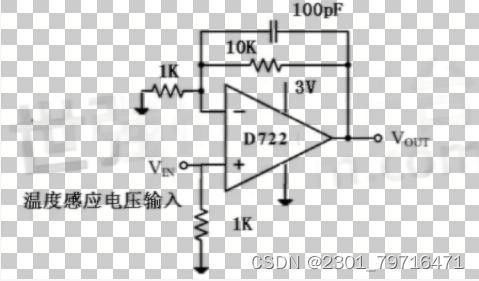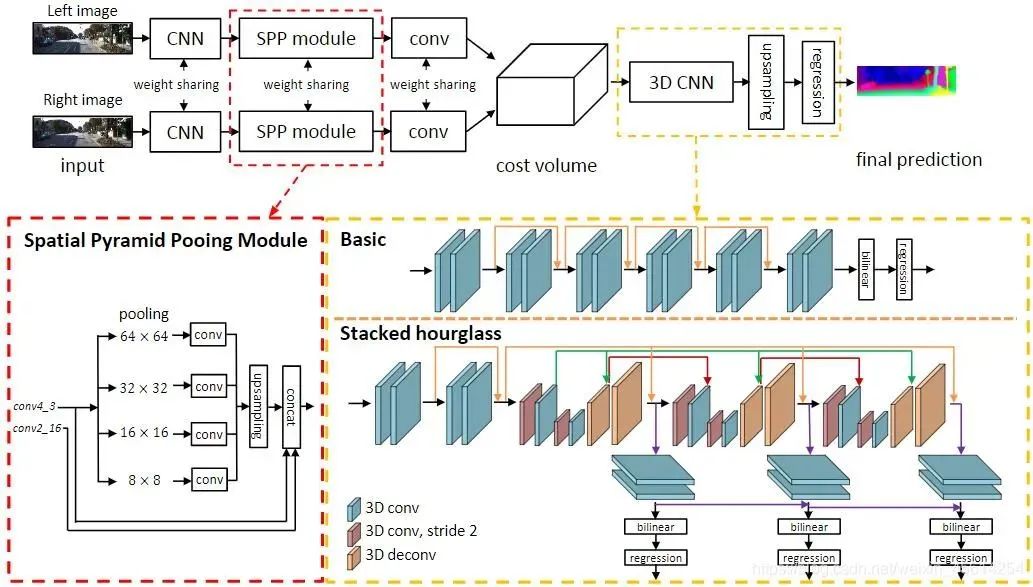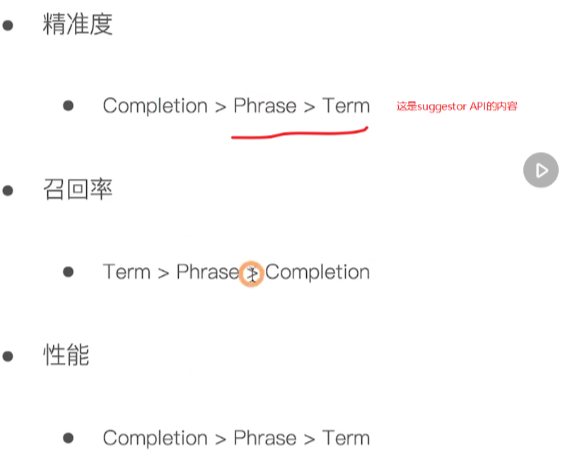文章目录
- STL容器之vector类
- 1、vector的介绍
- 2、vector的使用
- 2.1、vector的常见构造
- 2.2、vector的iterator的使用
- 2.3、vector空间增长问题
- 2.4、vector的增删查改
- 2.5、vector迭代器失效问题
- 3.vector的模拟实现

STL容器之vector类
1、vector的介绍
vector是表示可变大小数组的序列容器。
就像数组一样,vector也采用的连续存储空间来存储元素。也就是意味着可以采用下标对vector的元素进行访问,和数组一样高效。但是又不像数组,它的大小是可以动态改变的,而且它的大小会被容器自动处理。
本质讲,vector使用动态分配数组来存储它的元素。当新元素插入时候,这个数组需要被重新分配大小为了增加存储空间。其做法是,分配一个新的数组,然后将全部元素移到这个数组。就时间而言,这是一个相对代价高的任务,因为每当一个新的元素加入到容器的时候,vector并不会每次都重新分配大小。
vector分配空间策略:vector会分配一些额外的空间以适应可能的增长,因为存储空间比实际需要的存储空间更大。不同的库采用不同的策略权衡空间的使用和重新分配。但是无论如何,重新分配都应该是对数增长的间隔大小,以至于在末尾插入一个元素的时候是在常数时间的复杂度完成的。
因此,vector占用了更多的存储空间,为了获得管理存储空间的能力,并且以一种有效的方式动态增长。
与其它动态序列容器相比(deque, list and forward_list), vector在访问元素的时候更加高效,在末尾添加和删除元素相对高效。对于其它不在末尾的删除和插入操作,效率更低。比起list和forward_list统一的迭代器和引用更好。
使用STL的三个境界:能用,明理,能扩展。
2、vector的使用
2.1、vector的常见构造
(constructor)函数名称 接口说明 vector ()(重点) 无参构造 vector (size_type n, const value_type& val = value_type()) 构造并初始化n个val vector (InputIterator first, InputIterator last)(重点) 使用迭代器进行初始化构造 vector (const vector& x)(重点) 拷贝构造 #include <iostream> #include <vector> #include <list> using namespace std; void test_vector1() { vector<int> v; v.push_back(1); v.push_back(2); v.push_back(3); v.push_back(4); for (int e: v) { cout << e << " "; } cout << endl; } void test_vector2() { vector<int> v1; v1.push_back(1); v1.push_back(2); v1.push_back(3); v1.push_back(4); for (int e: v1) { cout << e << " "; } cout << endl; //用顺序表v1构造v2 vector<int> v2(v1); for (int e: v2) { cout << e << " "; } cout << endl; //用顺序表v1的迭代区间构造v3 vector<int> v3(v1.begin(), v1.end()); for (int e: v3) { cout << e << " "; } cout << endl; //构造长度为10并且各元素为1的顺序表 vector<int> v4(10, 1); for (int e: v4) { cout << e << " "; } cout << endl; } void test_vector3() { vector<int> v1; v1.push_back(1); v1.push_back(2); v1.push_back(3); v1.push_back(4); v1.insert(v1.begin(), 10); for (int e: v1) { cout << e << " "; } cout << endl; vector<int>::iterator pos = find(v1.begin(), v1.end(), 4);//find是函数模版 v1.insert(pos, 40); for (int e: v1) { cout << e << " "; } cout << endl; list<int> lt; lt.push_back(5); lt.push_back(6); lt.push_back(7); lt.push_back(8); for (int e: lt) { cout << e << " "; } cout << endl; vector<int> v3(lt.begin(), lt.end()); for (int e: v3) { cout << e << " "; } cout << endl; } //vector使用 int main() { // test_vector1(); // test_vector2(); test_vector3(); return 0; }
2.2、vector的iterator的使用
函数名称 接口说明 begin()+end()(重点) 获取第一个元素位置的iterator/const_iterator和获取最后一个元素的后一个位置的iterator/const_iterator rbegin()+rend() 获取最后一个元素位置的reverse_iterator/const_reverse_iterator和获取第一个元素的后一个位置的reverse_iterator/const_reverse_iterator void test_vector5() { vector<int> v1; v1.push_back(1); v1.push_back(2); v1.push_back(3); v1.push_back(4); vector<int>::iterator it1 = v1.begin(); while (it1 != v1.end()) { cout << *it1 << " "; ++it1; } cout << endl; vector<int>::const_iterator it2 = v1.begin(); while (it2 != v1.end()) { cout << *it2 << " "; ++it2; } cout << endl; } void test_vector6() { vector<int> v1; v1.push_back(1); v1.push_back(2); v1.push_back(3); v1.push_back(4); vector<int>::reverse_iterator it1 = v1.rbegin(); while (it1 != v1.rend()) { cout << *it1 << " "; ++it1; } cout << endl; } int main() { test_vector5(); test_vector6(); return 0; }
2.3、vector空间增长问题
函数名称 接口说明 size 获取数据个数 resize(重点) 改变vector的size capacity 获取数据的容量大小 empty 判断vector是否为空 reserve(重点) 改变vector的capacity void test_vector7() { vector<int> v1; cout << v1.size() << " " << v1.capacity() << endl; v1.push_back(1); v1.push_back(2); v1.push_back(3); v1.push_back(4); cout << v1.size() << " " << v1.capacity() << endl; v1.resize(10); cout << v1.size() << " " << v1.capacity() << endl; v1.reserve(11); cout << v1.size() << " " << v1.capacity() << endl; v1.resize(5); cout << v1.size() << " " << v1.capacity() << endl; cout << v1.empty() << endl; v1.resize(0); cout << v1.empty() << endl; } int main() { test_vector7(); return 0; }
- capacity的代码在vs和g++下分别运行会发现,vs下capacity是按1.5倍增长的,CLion和g++是按2倍增长的。这个问题经常会考察,不要固化的认为,vector增容都是2倍,具体增长多少是根据具体的需求定义的。vs是PJ版本STL,g++是SGI版本STL。
- reserve只负责开辟空间,如果确定知道需要用多少空间,reserve可以缓解vector增容的代价缺陷问题。
- resize在开空间的同时还会进行初始化,影响size。
// 测试vector的默认扩容机制 -- 这里CLion是2倍扩容,VS是1.5倍扩容 void TestVectorExpand() { size_t sz; vector<int> v; sz = v.capacity(); cout << "making v grow:\n"; for (int i = 0; i < 100; ++i) { v.push_back(i); if (sz != v.capacity()) { sz = v.capacity(); cout << "capacity changed: " << sz << '\n'; } } } /* vs:运行结果:vs下使用的STL基本是按照1.5倍方式扩容 making foo grow: capacity changed: 1 capacity changed: 2 capacity changed: 3 capacity changed: 4 capacity changed: 6 capacity changed: 9 capacity changed: 13 capacity changed: 19 capacity changed: 28 capacity changed: 42 capacity changed: 63 capacity changed: 94 capacity changed: 141 g++运行结果:linux下使用的STL基本是按照2倍方式扩容 making foo grow: capacity changed: 1 capacity changed: 2 capacity changed: 4 capacity changed: 8 capacity changed: 16 capacity changed: 32 capacity changed: 64 capacity changed: 128 */// 如果已经确定vector中要存储元素大概个数,可以提前将空间设置足够 // 就可以避免边插入边扩容导致效率低下的问题了 void TestVectorExpand() { size_t sz; vector<int> v; sz = v.capacity(); v.reserve(100); // 提前将容量设置好,可以避免一遍插入一遍扩容 cout << "making v grow:\n"; for (int i = 0; i < 100; ++i) { v.push_back(i); if (sz != v.capacity()) { sz = v.capacity(); cout << "capacity changed: " << sz << '\n'; } } }
2.4、vector的增删查改
函数名称 接口说明 push_back(重点) 尾插 pop_back(重点) 尾删 insert 在position之前插入val erase 删除position位置的数据 swap 交换两个vector的数据 operator[](重点) 返回position位置的数据 find 查找迭代区间在first到last之间的val,注意,这是函数模版 void test_vector8() { vector<int> v1; v1.push_back(1); v1.push_back(2); v1.push_back(3); v1.push_back(4); for (int e: v1) { cout << e << " "; } cout << endl; v1.pop_back(); for (int e: v1) { cout << e << " "; } cout << endl; cout << v1[0] << endl; v1.insert(v1.begin(), 10); for (int e: v1) { cout << e << " "; } cout << endl; vector<int>::iterator it = find(v1.begin(), v1.end(), 3); v1.erase(it); for (int e: v1) { cout << e << " "; } cout << endl; cout << "-----------------------" << endl; vector<int> v2; v2.push_back(10); v2.push_back(20); v2.push_back(30); v2.push_back(40); v2.push_back(50); v2.push_back(60); for (int e: v2) { cout << e << " "; } cout << endl; cout << "-----------------------" << endl; swap(v1, v2); for (int e: v1) { cout << e << " "; } cout << endl; for (int e: v2) { cout << e << " "; } cout << endl; } int main() { test_vector8(); return 0; }
2.5、vector迭代器失效问题
迭代器的主要作用就是让算法能够不用关心底层数据结构,其底层实际就是一个指针,或者是对指针进行了封装(如list,后面会讲)。
比如:vector的迭代器就是原生态指针T* 。因此迭代器失效,实际就是迭代器底层对应指针所指向的空间被销毁了,而使用一块已经被释放的空间,造成的后果是程序崩溃(即如果继续使用已经失效的迭代器,程序可能会崩溃)。解决办法是不使用insert和erase等后的原迭代器,或者使用insert和erase等后返回的迭代器。
对于vector可能会导致其迭代器失效的操作有:
会引起其底层空间改变的操作,都有可能是迭代器失效,比如:resize、reserve、insert、assign、push_back等。
#include <iostream> using namespace std; #include <vector> int main() { vector<int> v{1, 2, 3, 4, 5, 6}; auto it = v.begin(); // 将有效元素个数增加到100个,多出的位置使用8填充,操作期间底层会扩容 v.resize(100, 8); // reserve的作用就是改变扩容大小但不改变有效元素个数,操作期间可能会引起底层容量改变 // v.reserve(100); // 插入元素期间,可能会引起扩容,而导致原空间被释放 // v.insert(v.begin(), 0); // v.push_back(8); // 给vector重新赋值,可能会引起底层容量改变 // v.assign(100, 8); /* 出错原因:以上操作,都有可能会导致vector扩容,也就是说vector底层原理旧空间被释放掉, 而在打印时,it还使用的是释放之间的旧空间,在对it迭代器操作时,实际操作的是一块已经被释放的 空间,而引起代码运行时崩溃。 解决方式:在以上操作完成之后,如果想要继续通过迭代器操作vector中的元素,只需给it重新 赋值即可。 */ it = v.begin();//解决办法 while (it != v.end()) { cout << *it << " "; ++it; } cout << endl; return 0; }指定位置元素的删除操作(erase)
#include <iostream> using namespace std; #include <vector> int main() { int a[] = {1, 2, 3, 4}; vector<int> v(a, a + sizeof(a) / sizeof(int)); // 使用find查找3所在位置的iterator vector<int>::iterator pos = find(v.begin(), v.end(), 3); // 删除pos位置的数据,导致pos迭代器失效。 v.erase(pos); cout << *pos << endl; // 此处会导致非法访问,解决办法:不再访问pos v.push_back(5); v.push_back(6); v.push_back(6); v.push_back(5); v.push_back(8); for (auto e: v) { cout << e << " "; } cout << endl; //删除v里所有偶数 vector<int>::iterator it = v.begin(); while (it != v.end()) { if (*it % 2 == 0) { // v.erase(it);//这里最好不再用it it = v.erase(it);//解决办法 } else { ++it; } } for (auto e: v) { cout << e << " "; } cout << endl; return 0; }与vector类似,string在插入+扩容操作+erase之后,迭代器也会失效。
#include <string> using namespace std; int main() { string s("hello"); string::iterator sit = s.begin(); // 这里resize过后,会扩容,之前等sit的位置会改变 s.resize(100, 'w'); // 解决办法,给sit重新赋值 sit = s.begin(); while (sit != s.end()) { cout << *sit << " "; ++sit; } cout << endl; sit = s.begin(); while (sit != s.end()) { sit = s.erase(sit);//这里s.erase(sit)后的sit位置是之前sit的后一个位置 ++sit;//说明是隔一个元素删除 } for (char e: s) { cout << e << " "; } cout << endl; return 0; }
3.vector的模拟实现
- vector核心框架接口的模拟实现
vector.h文件// // Created by 徐鹏 on 2023/12/10. // #include <cstdio> #include <cstring> #include <list> using namespace std; #ifndef DEMO_01_VECTOR_H #define DEMO_01_VECTOR_H #endif //DEMO_01_VECTOR_H namespace xp { template<typename T> class vector { public: typedef T *iterator; typedef const T *const_iterator; vector() : _start(nullptr), _finish(nullptr), _end_of_storage(nullptr) {} // vector(const vector<T> &v) { // _start = new T[v.capacity()]; // memcpy(_start, v._start, v.size() * sizeof(T)); // _finish = _start + v.size(); // _end_of_storage = _start + capacity(); // } //拷贝构造函数 vector(const vector<T> &v) { reserve(v.capacity()); for (const auto &e: v) { push_back(e); } } template<class InputIterator> //构造迭代器区间 vector(InputIterator first, InputIterator last) { while (first != last) { push_back(*first); ++first; } } vector(size_t n, const T &val = T()) { resize(n, val); } //防止和上面迭代器区间搞混 vector(int n, const T &val = T()) { resize(n, val); } //赋值 ,这里vector<T> v在传值的时候就已经有拷贝构造了 vector<T> &operator=(vector<T> v) { swap(v); return *this; } T &operator[](size_t n) { return *(_start + n); } const T &operator[](size_t n) const { return *(_start + n); } ~vector() { if (_start) { delete[] _start; _start = _finish = _end_of_storage = nullptr; } } void swap(vector<T> v) { std::swap(_start, v._start); std::swap(_finish, v._finish); std::swap(_end_of_storage, v._end_of_storage); } void reserve(size_t n) { if (n > capacity()) { //开辟新空间 size_t old_size = size(); iterator tmp = new T[n]; //start不为空,在复制完内容需要释放空间 if (_start) { // //对于自定义类型,在进行delete[] _start 之后(自定义类型里面存在指针开辟空间问题的时候),会把原来的_start里面内容进行析构和空间释放 // memcpy(tmp, _start, old_size * sizeof(T)); // 解决方案,进行深拷贝 for (size_t i = 0; i < old_size; ++i) { tmp[i] = _start[i]; } delete[] _start; } _start = tmp; //这里要注意,得用之前的size,不然新size使用内联进来就是_finish = _start + _finish - _start _finish = _start + old_size; _end_of_storage = _start + n; } } void resize(size_t n, T val = T()) { if (n > capacity()) { size_t fill = _start + n - _finish; reserve(n); //填补之前finish后面fill个数据 while (fill != 0) { *_finish = val; _finish++; fill--; } } } void push_back(const T &val) { if (_finish == _end_of_storage) { size_t newCapacity = capacity() == 0 ? 4 : 2 * capacity(); reserve(newCapacity); } *_finish = val; ++_finish; } void pop_back() { --_finish; } void insert(iterator pos, const T &val) { assert(pos >= _start); assert(pos <= _finish); if (_finish == _end_of_storage) { size_t len = pos - _start; size_t newCapacity = capacity() == 0 ? 4 : 2 * capacity(); reserve(newCapacity); pos = _start + len;//防止增容量后,pos位置还是之前被释放的空间 } //memmove(pos + 1, pos, sizeof(T) * (_finish - pos)); //浅拷贝,扩容可能存在迭代器失效问题 iterator end = _finish - 1; while (pos <= end) { *(end + 1) = *end; --end; } *pos = val; ++_finish; } iterator begin() { return _start; } const_iterator begin() const { return _start; } iterator end() { return _finish; } const_iterator end() const { return _finish; } size_t size() const { return _finish - _start; } size_t capacity() const { return _end_of_storage - _start; } private: iterator _start = nullptr; iterator _finish = nullptr; iterator _end_of_storage = nullptr; }; void test_vector1() { vector<char> v; v.reserve(10); cout << v.size() << " " << v.capacity() << endl; // v.resize(100); v.resize(100, 'x'); cout << v.size() << " " << v.capacity() << endl; } void test_vector2() { vector<int> v; v.push_back(1); v.push_back(2); v.push_back(3); v.push_back(4); v.push_back(5); for (auto e: v) { cout << e << " "; } cout << endl; } void test_vector3() { vector<string> v; v.push_back("hh"); v.insert(v.begin(), "2"); v.insert(v.begin(), "2"); v.insert(v.begin(), "2"); v.insert(v.begin(), "2"); v.insert(v.begin(), "2"); v.insert(v.begin(), "2"); v.insert(v.begin(), "2"); v.insert(v.begin(), "2"); for (auto e: v) { cout << e << " "; } cout << endl; } void test_vector4() { vector<string> v1; v1.push_back("hhh"); v1.push_back("www"); for (auto e: v1) { cout << e << " "; } cout << endl; vector<string> v2; v2.push_back("lllll"); v2.push_back("nnnnn"); for (auto e: v2) { cout << e << " "; } cout << endl; cout << "----------------------" << endl; v1 = v2; for (auto e: v1) { cout << e << " "; } cout << endl; for (auto e: v2) { cout << e << " "; } cout << endl; } void test_vector5() { vector<string> v; v.push_back("w"); v.push_back("s"); v.push_back("x"); v.push_back("p"); cout << v[1] << endl; } void test_vector6() { vector<string> v; v.push_back("w"); v.push_back("s"); v.push_back("x"); v.push_back("p"); v.push_back("p"); v.push_back("p"); v.push_back("p"); v.push_back("p"); v.push_back("psdf"); v.push_back("pdsf"); v.push_back("pfd"); v.push_back("pdsf"); v.insert(v.begin(), "sdas"); for (auto e: v) { cout << e << " "; } cout << endl; } void test_vector7() { vector<string> v; v.push_back("w"); v.push_back("s"); v.push_back("x"); v.push_back("p"); v.push_back("p"); v.push_back("p"); vector<string> v2(v.begin(), v.end()); for (auto e: v2) { cout << e << " "; } cout << endl; int a[] = {1111, 222, 222, 3}; vector<int> v3(a, a + 4); for (auto e: v3) { cout << e << " "; } cout << endl; list<string> lt; lt.push_back("hjakds"); lt.push_back("wq"); lt.push_back("qw"); lt.push_back("w"); vector<string> v4(lt.begin(), lt.end()); for (auto e: v4) { cout << e << " "; } cout << endl; vector<int> v5(5, 5); for (auto e: v5) { cout << e << " "; } cout << endl; } }
main.h文件#include <iostream> #include "vector.h" //vector 模拟实现 int main() { // xp::test_vector1(); // xp::test_vector2(); // xp::test_vector3(); // xp::test_vector4(); // xp::test_vector5(); // xp::test_vector6(); xp::test_vector7(); return 0; }
- 使用memcpy拷贝问题
在reserve接口中存在扩容情况,对于内置类型,使用memcpy函数对数据进行拷贝不存在什么问题,但是对于自定义类型,如string类,在使用memcpy进行拷贝的时候,虽然将原数据拷贝到了新空间上,但是string类的成员变量存在指针
_str,如果直接将该数据直接拷贝过来,那么新空间里的_str和旧空间的_str会指向同一块空间,在旧空间释放后,新空间的_str指针就变成了野指针。其实就是memcpy的浅拷贝问题,解决办法就是使用深拷贝,即直接把旧空间的数据采用赋值的方式(string赋值是深拷贝)放到新空间中。
使用memcpy的代码
void reserve(size_t n) { if (n > capacity()) { //开辟新空间 size_t old_size = size(); iterator tmp = new T[n]; //start不为空,在复制完内容需要释放空间 if (_start) { memcpy(tmp, _start, old_size * sizeof(T)); delete[] _start; } _start = tmp; //这里要注意,得用之前的size,不然新size使用内联进来就是_finish = _start + _finish - _start _finish = _start + old_size; _end_of_storage = _start + n; } }
这里就导致在释放完
_start后,_tmp中的_str变成野指针。解决办法:使用string的赋值进行深拷贝
void reserve(size_t n) { if (n > capacity()) { //开辟新空间 size_t old_size = size(); iterator tmp = new T[n]; //start不为空,在复制完内容需要释放空间 if (_start) { // //对于自定义类型,在进行delete[] _start 之后(自定义类型里面存在指针开辟空间问题的时候),会把原来的_start里面内容进行析构和空间释放 // memcpy(tmp, _start, old_size * sizeof(T)); // 解决方案,进行深拷贝 for (size_t i = 0; i < old_size; ++i) { tmp[i] = _start[i]; } delete[] _start; } _start = tmp; //这里要注意,得用之前的size,不然新size使用内联进来就是_finish = _start + _finish - _start _finish = _start + old_size; _end_of_storage = _start + n; } }结论:如果对象中涉及到资源管理时,千万不能使用memcpy进行对象之间的拷贝,因为memcpy是浅拷贝,否则可能会引起内存泄漏甚至程序崩溃。
OKOK,C++ STL容器之vector类就到这里。如果你对Linux和C++也感兴趣的话,可以看看我的主页哦。下面是我的github主页,里面记录了我的学习代码和leetcode的一些题的题解,有兴趣的可以看看。
Xpccccc的github主页




















